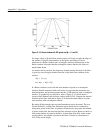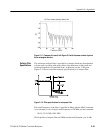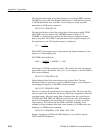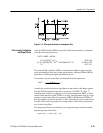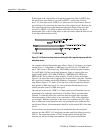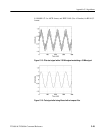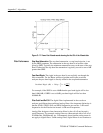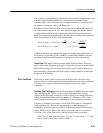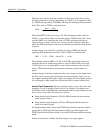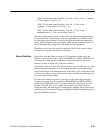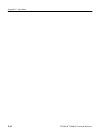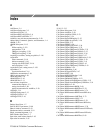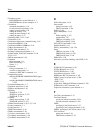
Appendix C: Algorithms
C–32
TVS600 & TVS600A Command Reference
When this error occurs, there are a number of things that can be done to allow
the filter generation to succeed. One change you could do is to change the value
for TWID (and equivalently TWIDHZ) and keep the remaining filter parameters
fixed. This value of TWID is calculated from:
TWID +
SREJ – 1.9794
7.1785 @ (MaxNPTS)
Where MaxNPTS in this case is set to 102. The maximum possible value for
TWID is 1 (for realistic filters it is desirable to have TWID less than 0.2). If the
specified SREJ is too large then the value of TWID calculated in the above
expression may exceed 1. In this case, it is not possible to design a filter that
meets the SREJ specifications and uses less than the maximum possible number
of points.
Another change you could do is to change the value of SREJ and keep the
remaining filter parameters fixed. This value of SREJ is calculated from:
SREJ + 7.1785 @ TWID @ (MaxNPTS) ) 1.9794
The minimum value for SREJ is 15 dB. If the TWID was initially chosen too
small then the above formula may predict a value for SREJ which is less than
15 dB. In this case, it is impossible to create a filter which meets the specifica-
tion for TWID and which uses less than the maximum possible number of
points.
Another change would be to acquire the data using a longer record length. Since
the filter can have more points if the input data record length is larger, you can
use a tighter specified filter with a longer record length. In our example, going to
a record length of 4096 would have allowed the filter to operate without error.
Incorrect Cutoff Frequencies. The basic problem is that you can’t have the cutoff
frequency for low or highpass filters close to 0 or Nyquist. For bandpass and
notch filters, there is the additional constraint that start and stop frequencies can’t
be too close to each other. The rules are as follows:
H Insure that the cutoff frequency (LPAS or HPAS) minus half the transition
width is greater than 0.
H Insure that the cutoff frequency (LPAS or HPAS) plus half the transition
width is less than Nyquist.
For bandpass/notch filters, insure that START minus half the transition width is
greater than 0, STOP plus half the transition width is less than Nyquist, and
START plus half the transition width is less than STOP minus half the transition
width.
If these constraints are violated, the following error messages appear:



